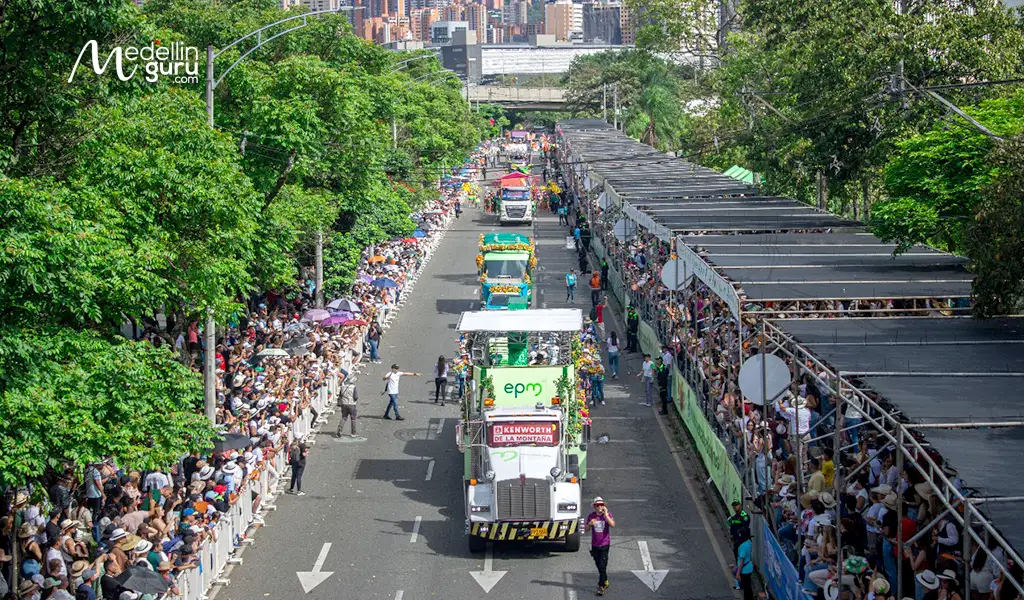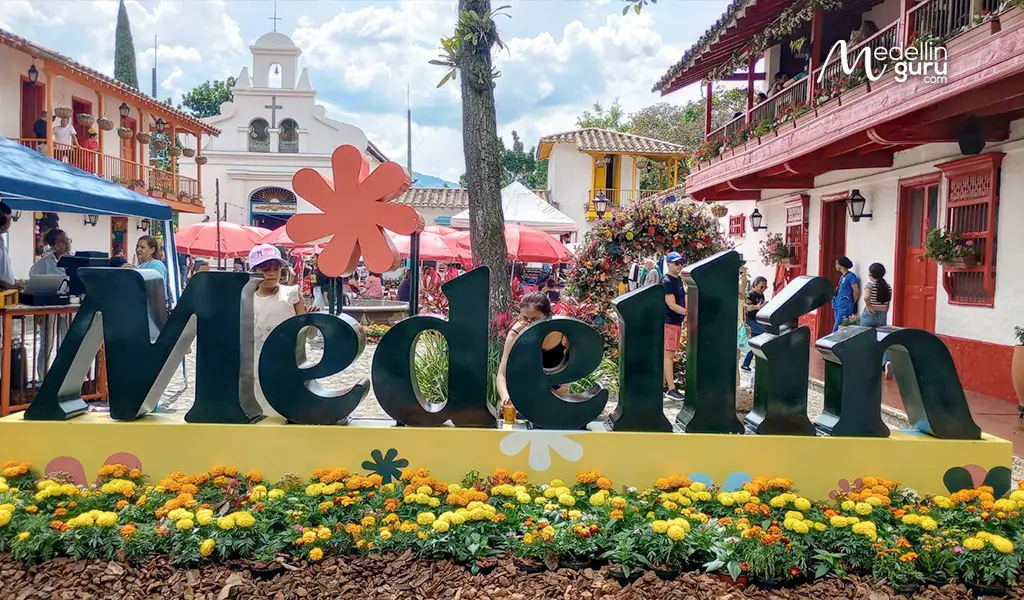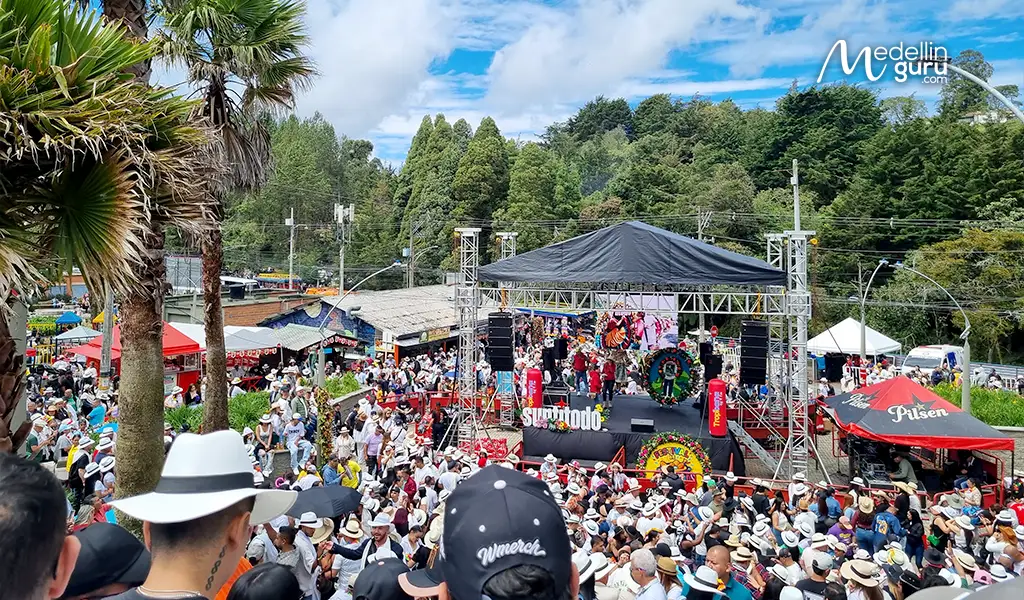From August 1st to August 10th, 2025, we experienced the 68th edition of the Flower Festival in Medellìn 2025, where once again the city dressed up for the celebration, decorated its streets with flowers, traditions, culture, music, and the greatest feeling of pride, happiness, and enchantment for the immense silletera heritage that attracts the eyes of millions of people during these days.
We had the great honor of sharing these days with thousands of people who, among locals and visitors, had their hearts stolen just as we did by the Flower Festival in Medellin 2025, for which we were able to provide special coverage that we now want to share with all of you. The impressions, details, feelings, and hundreds of memories in photos and videos that we hope will move you just as much as they moved us, and encourage you to experience these festive days again for the 69th edition next year, which we are already longing for.


The more than 200 events at the annual Paisa Festival always drew a crowd. Initial reports indicate a booming Feria de las Flores, from the Sancochos Festival in Santa Elena, the inaugural concert, academic, cultural, artistic, and musical events at dozens of locations throughout the city, daily music stages in the neighborhoods, and every parade that took place—all confirming that there truly was a Feria de las Flores for everyone in Medellín. Next, you’ll see how we lived these days with the best local spirit, paisa vibes, and Medellin Gurú style.

Sancocho Festival at Santa Elena
For us, the Medellín Flower Festival in Medellin 2025 began triumphantly and deliciously with El Festival de Sancochos, one of the most emblematic gastronomic events in Santa Elena where this delicious typical dish made from potato, corn, yuca, plantain, beef, chicken, bone, and an exquisite broth delighted more than 20 thousand attendees who were able to enjoy this memorable day. However, attendees once again exceeded the capacity of the district (Corregimiento) to receive such a quantity of visitors, so out of those more than 20 thousand inhabitants, we were part of the select group that managed to reserve, buy, and enjoy a delicious sancocho dish.

Friends, with this precedent, we have a first recommendation for this event in later editions. We arrived the night before the event and easily accessed Santa Elena park around 9:30 in the morning (where, believe it or not, half the park was already full—seriously, do these folks sleep there?). However, from then on, cars, buses, motorcycles, minibuses, and “chivas” full of people kept arriving and arriving, while absolutely NO ONE left the event. It was like a black hole of festivity, sucking everyone in! Don’t be scared, none of this spoils the official inauguration of the Flower Festival in the cradle of the “silletera” tradition, as long as you keep in mind these details that will make a difference in your experience:
- If you can, schedule in advance. In Santa Elena, there are some hotels (very few) or experiences in “silletera” farms that can provide you with lodging and make the commute easier, allowing you to access the event on time and comfortably, ensuring your “sancocho” with peace of mind.
- If you purchase a package with a tourism agency, make sure they go up at a reasonable time on the day of the event. If the agency tells you they will go up to Santa Elena from 10 AM, believe us, it will be too late, the traffic will be infinite, and, as happened to some people, it will even be faster to walk the rest of the way.
- Have a lot of patience. When the event ends, the descent to Medellin is extremely delayed; we are not exaggerating, it is an odyssey, but if you keep this in mind, you will continue to enjoy the event, or why not? You can stay overnight in Santa Elena with your prior reservation, and you can rest comfortably and descend the next morning.
Despite the seemingly insurmountable crowds, attending this event is truly one of the best decisions you can make. It’s an explosion of local culture, a high dose of authentic Paisa taste, and an experience that will leave you grinning from ear to ear (even if you’re a little squished). You’ll be immersed in the heart of a beloved tradition, surrounded by the vibrant energy of a community that truly knows how to celebrate. Trust us, your palate, your taste buds, your eyes, before the beautiful landscapes of Santa Elena, and your whole being will be grateful for this experience with the most authentic ‘paisa’ flavor, leaving you wanting to experience the Flower Festival fully.

With each “chiva” that enters, the captivating smell of the over 20 competing stews will enchant you, every smile of the attendees, the festive rhythm of the music, the ponchos, hats, ruanas, and each shot of “guaro” will make you feel like an authentic Paisa, and not just any, but the purest and most original, the rural Paisa.
Flower Festival Inaugural Concert
The Flower Festival in Medellin 2025 officially began with the traditional Inaugural Concert in the Obelisco Sector, on Centenario Avenue, next to the Atanasio Girardot Stadium, which took place on Friday, August 1, 2025, where 50,000 attendees participated in 10 public events and more than 500 artists filled the city with joy, foretelling the most festive and joyful days of the year for the Paisa culture.
To the rhythm of songs by Jorge Celedón, Jessi Uribe, Andy Rivera, and Fernando González, the Flower Festival began with great rhythm, where people started arriving from 5 in the afternoon. We were also able to attend from 7 at night, and the obelisk sector in front of the stage was practically full, but despite this, we were able to find a spot comfortably. In addition, some details made a significant difference, such as easy access to mobile restrooms, which were properly cleaned, varied food options, and authorized liquor stalls at absolutely fair and reasonable prices, which made the experience safer, more reliable, and peaceful. There was also the presence of police units and the Floresta and Estadio Metro stations just a few minutes’ walk away.
There, at the Pilsen stand, we got some beautiful “muleras,” which refers to a traditional, colorful woven scarf or shawl, often made of cotton or wool, being a distinctive accessory typically worn by “arrieros” (muleteers) and people from rural areas, especially during cooler weather or as part of traditional attire. which could be personalized with a name. We spent an unforgettable night, which is enjoyed even more in the company of family and friends who passionately share these festivities.


Semifinal of the Trova Festival
What to say about Trova? On Saturday, August 2nd, we visited Parque de los Deseos, located next to the Universidad Metro Station, the University of Antioquia, and the Botanical Garden, to experience one of the most significant and representative symbols of Paisa culture: the trova.
This ingenious way of improvisation, spontaneity, rhythm, and rhyme makes hearts vibrate, highlights the ingenuity of its performers (the “trovadores”), and envelops the Flower Festival in a unique Paisa, rural, authentically local setting, where laughter, applause, admiration, skill, and the nervousness of knowing who will win take over everyone.


The location was the best possible, with more than 1000 people gathered around on an afternoon/evening of joy and charm, where the weather was conducive to enjoying such a beautiful evening, from the comfort of the seats provided by the Mayor’s Office of Medellin, who gave this grand event the treatment, recognition, and dignity it deserves, designating on Friday, August 8th, the king and queen of Trova, as the greatest interpreters of traditional “trova” in the country.
Avenida Primavera Parade
The first Grand Official Parade took to the city streets on Sunday, August 3rd, where troupes, trucks, and large floats decorated with flowers paid homage not only to the beauty of the floral arrangements but also to the country’s musical richness. Great national performers delighted the public from these floats, performing their greatest hits, songs that have put Medellin and Colombia on the front page of the music industry.
This day was a historic day for the Flower Festival in Medellín 2025, as there were many other events in the city such as the Canine Walk, in addition to the start of the Night Cultural Park, which exceeded expectations, registering only during that day more than 2,015,000 attendees in more than 15 public events that took place that day (not counting the more than 420,000 pets that participated in the walk.)


For the Avenida Primavera Parade, we participated in the random designation that the Mayor’s Office of Medellín designed to benefit thousands of locals and foreigners who won free tickets, allowing them to watch the parade from one of the privileged boxes overlooking the parade. The assignment consisted of calling a telephone line authorized by the Mayor’s Office, where, with full name and identification number, said data was entered into software that would then randomly choose the winners of 18,000 double passes, also randomly assigning them a parade.
Imagine, more than 50,000 people participated, and we were able to obtain a double pass for this inaugural parade. We felt like we’d won the lottery, but instead of cash, we got a prime spot to admire some huge flowers and majestic floats with mini-private concerts along the way during the parade. Priorities, right?
The organization, logistics, and speed of entry for people into the boxes were absolutely winning, with everyone easily finding their assigned seating. This space also offered fast food, snacks, appetizers, small versions of popular restaurants, and the sale and distribution of authorized liquor from FLA and Pilsen. Additionally, the beauty, commercial offers, and even gifts provided by some commercial brand activations present there were noteworthy, as they had boxes specifically designated for their employees, making the Flower Festival shine in many ways, in many colors, and elevating the name of more than a dozen brands that joined the celebration of these festivities, allowing an unforgettable experience for their employees and those who passed near their boxes.
This is something that, as you will see later, we saw in every parade we were fortunate enough to participate in this edition of the Flower Festival.
We saw artists such as Pipe Peláez, Reykon, Yeison Jiménez, Nelson Velásquez, Fruko y sus tesos, El Tropicombo, Álex Martínez, Ciro Quiñónez, and many more, cross by in beautiful floats, giving energy and variety, and making the public thrill to the sound of their songs.


What is a Day of the Week during The Flower Festival?
August 4th, 5th, and 6th were intermediate days between the big celebrations of the Flower Festival, which would increase starting from the public holiday on August 7th. Thousands of people took advantage of these days to do circuits, group tours, family tours, or even personal tours to soak up the magic of the dozens of events that could be visited daily. So much so that during these days, more than 200,000 attendees participated in about 35 public events.
The morning of August 5th marked the beginning of our adventure in Florecer: Orquídeas, Naturaleza y Tradiciones. This event stood out as the most impressive floral exhibition of the entire Fair, captivating our senses with an abundance of colors and fragrances. More than 50,000 flower stems, 350 varieties of exotic orchids, and the talent of 180 Colombian artisans transformed the space into an authentic Garden of Eden. Each floral arrangement was a work of art, reflecting the dedication and ingenuity of Colombian growers and creators, and reminding us of the immense natural treasure that Colombia possesses as a global flower producer. The experience was an ode to biodiversity and tradition, a visual and olfactory feast that left us marveling at the country’s botanical richness.
At midday, our journey took us to the iconic Pueblito Paisa, at the top of Cerro Nutibara. This place, an architectural replica of traditional Antioquian towns, became the setting for the vibrant “Placitas de Flores.” Here, the Festival unfolded all its cultural, artistic, gastronomic, theatrical, and musical splendor, offering entertainment for all ages. Pueblito Paisa, with its beautifully decorated baseboards, colorful walls, traditional lanterns, and stone paths, is already a jewel in itself that has no comparison during these festivities, with its privileged view of the city from one of the city’s natural lungs, beautifully adorned with flowers, a scene that was etched in our retinas. For foreign visitors, Pueblito Paisa stood out as a must-see place during these days, as there they had the opportunity to enjoy a unique “trova paisa” show, where the improvisers even surprised the audience by “troving” in English, generating laughter and applause. The afternoon passed between laughter, music, dancing, and the warmth of Paisa traditions, allowing us to immerse ourselves completely in the joy of these days, where the energy was palpable, and the festive atmosphere made every moment memorable.
Finally, as evening fell, the day culminated at the musical stage of Aeroparque Juan Pablo II, located in the Belén neighborhood. This was one of the many strategic points in the city where locals and visitors united to enjoy free concerts with high-caliber and renowned artists. The diversity of genres and the talent of the performers kept the crowd dancing and singing late into the night, providing the perfect end to a day authentically representative of Medellín and its Flower Festival.
Classic and Antique Cars Parade
The Classic and Antique Car Parade, one of the most traditional events of the Flower Festival, filled the streets of Medellin with flowers, color, and joy on August 7th, with 365 vintage and classic automobiles and 35 motorcycles traveling 17 kilometers from Universidad Pontificia Bolivariana to Universidad EAFIT. This event, along with 15 other public events, attracted more than 1,300,000 people, according to figures from the Mayor’s Office, with this parade, organized by the Antioquia Transport Museum Foundation (FMTA) and the EL COLOMBIANO newspaper, being the most attended.


This parade never disappoints. Year after year, it is one of the highest points of the Flower Festival, where families abound throughout the entire parade, which despite being one of the longest, always seems not to be, as once the display of so many antique cars begins, completely beautiful as a reflection of another era, time accelerates and emotion overflows.
Adding another layer of commendation, the meticulous order, impeccable logistics, and foresightful planning orchestrated by the Mayor’s Office of Medellín for the designated viewing boxes truly deserve recognition. These boxes, once again, proved to be a pivotal aspect of the parade’s success, providing an elevated viewing experience that enhanced the enjoyment of countless attendees. Even the intermittent rain, which, though not torrential, could have dampened spirits, failed to diminish the enthusiasm of any of the spectators present. The comfort offered within these designated areas, the convenient proximity to essential basic services, and the unparalleled vantage points they provided collectively ensured that this parade was not only one of the most enjoyable but also one of the most impressively curated events of the festival. It was a revelation to witness the sheer volume and diversity of historical car models Medellín proudly houses – an astounding array of brands, sizes, colors, and, most remarkably, all maintained in such pristine condition.
Without a shadow of a doubt, this parade serves as a powerful confirmation of Medellín's inherent wonder and its remarkable ability to excel in every endeavor it undertakes. Any discerning classic car enthusiast would readily attest to the profound truth of what we are conveying.
Silleteros Parade
540 silleteros majestically closed the Flower Festival, carrying authentic works of floral art in different categories and choosing Juan Pablo Sánchez as the absolute winner. With a monumental silleta weighing approximately 100 kilograms, he paraded with his family for 3.4 kilometers amidst applause, congratulations, and tears of joy from the attendees.
The 2025 edition of the Silleteros Parade was a vibrant reminder of the strength and beauty of tradition. From early in the morning, the city pulsed with unmistakable energy. Entire families gathered along the route, looking for the best spot to witness the silleteros pass by. It’s undeniable how the city eagerly turns out for the silleteros, recognizing in them the pinnacle of Antioquian identity, where the cheers grew louder, the applause more widespread, and the admiration manifested in shouts, songs, and endless photos and videos. And what about the silleteros? They are the heart of the fair, the guardians of a centuries-old tradition, the bearers of Paisa pride, the privileged children of a city that surrenders to their passing and to the beauty of the flowers they carry on their backs. Their enthusiasm mirrored that of thousands, a connection that transcends generations.
This year, the parade gave us anecdotes that will be etched in memory. Elderly silleteros, with faces weathered by the sun and a sincere smile, always stopped for a moment to greet the crowd. Their silletas, monumental works with multicolored flowers, seemed to vibrate with each of their steps.
To top it off, another moving moment was when a young silletera stopped in front of us and, giving us the most beautiful smile and her best pose, extended her hand to share with us the most precious fruit of her land: the flower. And not just any flower, because it wasn’t just the flower for the flower’s sake, it’s what it means, the months of care, cultivation, patience, waiting that they then proudly and selflessly share with the entire city. These small gestures, amidst the magnitude of the event, highlighted the humanity and heart of the silletera tradition, making the 68th edition of the Medellín Flower Festival in 2025 an unforgettable chapter in the history of the Flower Festival.

When will it be your turn? And if this year was your first or another experience, what captivated you the most?
Medellin Guru's comprehensive Colombian culture series
In Medellin Guru, we love Colombia, and we usually write many blogs about Colombian culture, places to visit, and other tips for all expats to have a reliable guide and valuable and relevant information about Colombia. Read our blogs about Colombian Culture here:
- Top Tourist Attractions in Colombia: Top Things to Do
- Top Things to Do in Medellín and Nearby: Top Tourist Attractions
- How to be an Expat in Colombia: 12 Tips to be a Successful Expat
- Top Things to Do in Cali and Nearby: Top Tourist Attractions
- Celebrating July 20th: Colombia Independence Day
- Norte de Santander: 5 Escapes for a Weekend Adventure
- Unlock Ipiales in 24 Hours: Your Essential Adventure Blueprint!
- Pasto: Discover the wonders of the Surprise City
- Top Popular Colombian Drinks to Try When You Visit Colombia
- Villa de Leyva: A Colonial Gem in the Colombian Andes
- Traditional Colombian Food Dishes You Must Try in Colombia
- Medellin Guru Launch 2023: Gentrification, Tourism and Investment
- Popular Colombian Desserts You Must Try While in Colombia
- Exotic Tropical Fruits of Colombia a Fruit Lovers Paradise
- Popular Colombian Soups to Try When You Visit Colombia
- Día de las Velitas: Day of Candles Tradition in Colombia on December 7
- Things in Colombia That May Be Strange for Foreigners
- Things Colombians Do That Foreigners May Find Weird
- Popayán: A Well-Preserved Colonial Gem in Colombia Worth Visiting
- Tejo: A Colombian Game That Rewards You for Explosions
Other things to see and do in Colombia
- Caño Cristales – the most beautiful river in Colombia, which has also been called the most beautiful river in the world by some people.
- Carnival in Barranquilla – the second largest carnival in the world.
- Cartagena – Oozing history, romance and sun-drenched beaches, the allure of historical Cartagena is hard to resist.
- Ciudad Perdida – the site of an ancient city in Colombia that is older than Machu Picchu in Peru.
- Colombia’s Pacific coast – often overlooked by tourists visiting Colombia but offering untamed nature and undiscovered beauty that is off the beaten path for most foreign tourists.
- Desierto de la Tatacoa – the second largest arid zone in Colombia is Tatacoa Desert, which has surreal desert landscapes and some of the best stargazing in Colombia.
- Guatapé – a picturesque pueblo near Medellín known for its huge rock and lake. And it’s likely the most visited pueblo in Colombia by foreigners.
- La Guajira Peninsula – one of the most visually stunning places in South America, which is located on the northern tip of Colombia where the desert meets the sea.
- Las Lajas Sanctuary – the most beautiful church in Colombia, which has also been called the most beautiful church in the world.
- Medellín’s Christmas lights – Medellín’s annual world-class Christmas lights known as Alumbrados Navideños.
- Feria de Las Flores Medellin – Medellín’s world-famous flower festival each year.
- Parque Nacional Natural Los Nevados – a popular national park in Colombia located in the heart of the Colombian coffee region.
- Parque Tayrona – known for its beautiful beaches and the world’s highest coastal mountain range.
- Popayán – a colonial gem in Colombia best known for its white buildings and churches, it’s a city off the beaten path for foreign tourists but is definitely worth visiting.
- Rio Claro Nature Reserve – located about three hours from Medellín, Rio Claro is the perfect place to unplug from hectic daily life and enjoy a picturesque crystal-clear river, canyon and tropical rainforest.
- Salento and the Cocora Valley – Salento is a picturesque pueblo in Colombia’s coffee region and the nearby Cocora Valley is one of the most striking landscapes found in Colombia.
- San Agustín Archaeological Park – the largest group of pre-Columbian monuments and megalithic statues in South America and is a UNESCO World Heritage Site.
- San Andrés – Colombia’s Caribbean island which is a UNESCO World Biosphere Reserve featuring many beaches, islets and coral reefs that are filled with flora and fauna.
- San Gil – Colombia’s adventure capital that is full of things to do including white water rafting, paragliding, caving, rappelling, hiking and much more.
- San Jose del Guaviare – a hidden gem and eco-tourism location off the beaten path and offering wildlife watching, jungle trekking and delving into Colombia’s prehistoric past.
The Bottom Line: Relive the Best of Medellin’s Flower Festival 2025: Recap & Photos
Our Medellin Guru team had the immense pleasure of experiencing the 2025 Flower Festival to the fullest, covering every event from the Sancochos Festival to the majestic Silleteros Parade. We witnessed the vibrant Paisa culture, the contagious joy of thousands of attendees, and the impeccable organization that made this 68th edition a true success. The orchids in “Florecer”, the improvised trova in Pueblito Paisa, the classic car parade, the beautiful flowers on the backs of the silleteros, and the excitement in every corner of the city left us with indelible memories and reaffirmed why Medellín is such a special place.
Get ready for the 69th edition next year! We invite you to join us and experience the magic of the Flower Festival firsthand. It will be an unforgettable experience you won’t want to miss!
Medellin Guru Social media
Be part of our community. Find out about news, participate in events and enjoy the best of the city.

